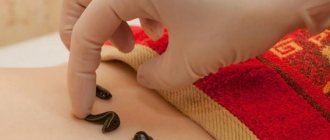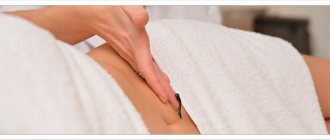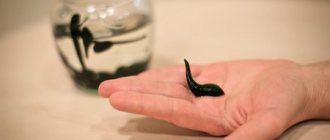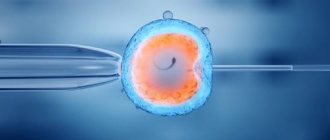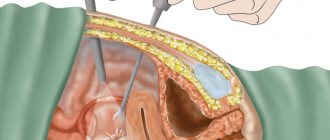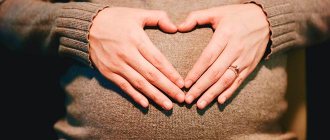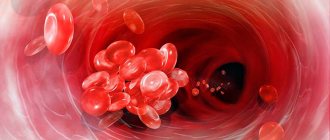HYRUDOTHERAPY FOR ENDOMETRIOSIS
To understand what effect the use of leeches has on endometriosis, you need to find out the causes of the disease.
Let's look at some of them:
- inflammatory processes in the pelvis, - hormonal imbalance, - heredity, - weakened immunity, - endocrine metabolism disorders.
Now let's look at the properties of leech saliva. This type of annelid worm injects a powerful cocktail of vitamins and microelements into the human blood. As a result, blood circulation improves, hormone levels stabilize, and immunity is strengthened. That is, leeches effectively fight the root causes of endometriosis.
Hirudotherapy for ovarian endometriosis
Ovarian endometriosis refers to the external subtype of the disease. It is extremely responsive to hormonal changes. Hirudotherapy stabilizes hormone levels and effectively fights the endometrium in the absence of cystic formations.
Leeches for endometriosis - increase the likelihood of pregnancy
Endometriosis is one of the common causes of infertility. It also provokes varicose veins of the pelvic organs. At the initial stage of treatment, the use of leeches is acceptable. The course is prescribed after consultation with a specialist.
Endometriosis and its types
A disease such as endometriosis occurs due to hormonal imbalance, during which a significant amount of estrogen and only a small amount of progesterone is formed in the ovaries. As a result, endometrial cells leave the uterus and attach to other organs such as:
- intestines;
- fallopian tubes and ovaries;
- bladder, etc.
The disease can be divided into several types:
- external type - usually manifests itself in damage to organs located outside the uterus (for example, the bladder, ovary or intestines);
- internal type - expressed in the germination of endometrial cells inside the fallopian tubes and uterus.
Hirudotherapy for endometriosis: price
The price depends on the specifics of the disease and is calculated based on the number of sessions performed. The hirudotherapist determines the cost individually after consultation with the patient, receiving information about the diagnosis and test results.
Hirudotherapy for endometriosis, placement of 3 leeches – 1500 rubles Hirudotherapy for endometriosis, placement of 5 leeches – 2500 rubles Procedure for placement of 3 leeches for endometriosis – 1500 rubles Procedure for placement of 5 leeches for endometriosis – 2500 rubles Procedure for placement of 3 leeches for endometriosis endometriosis of the uterus – 1500 rubles Procedure for placing 5 leeches for endometriosis of the uterus – 2500 rubles Procedure for placing 3 leeches for ovarian endometriosis – 1500 rubles Procedure for placing 5 leeches for ovarian endometriosis – 2500 rubles
The effectiveness of hirudotherapy: what evidence-based medicine says
N.V. Startseva, I.B. Lomaeva, Yu.V. Beda in 2005 assessed the effectiveness of hirudotherapy in patients with endometriosis. 82 women took part in the study. Patients were selected for whom surgical treatment was not indicated - with foci of endometriosis difficult to access for surgical intervention. The sample also included women after ineffective hormonal therapy and young patients with adenomyosis (endometriosis of the uterus). Removal of the uterus in the latter case would lead to a complete loss of reproductive function.
Benefits and harms
Leeches for endometriosis help women cope with the painful signs of the disease. They stimulate certain points on the body, as a result of which pelvic pain goes away and bleeding decreases. It is important to know where to place natural healers in order to obtain a therapeutic effect. For this reason, independent use of hirudotherapy is not recommended.
In addition, the leech itself contains special components. During a bite, they enter the woman’s body, stimulating blood and lymph flow. There is a healing effect on the reproductive system and the body as a whole. Hirudin present in their saliva has the following effects:
- normalizes the blood clotting process, as a result of which the activity of endometriosis foci is suppressed;
- eliminates the inflammatory process in individual segments of the small pelvis (depending on the location of the leech);
- helps cleanse blood vessels and prevents the formation of blood clots;
- reduces the amount of uterine bleeding during menstruation.
Statistics show that approximately 8 out of 10 patients who have undergone leech treatment leave positive reviews. In women, the cycle normalizes, natural ovulation is restored, and discomfort goes away.
Leeches are actively used in gynecology and other branches of medicine. The only drawback is the high cost of the procedure. If the worms are used ineptly and incorrectly placed, the patient may be left with scars at the site of the bites. The aesthetic side of this treatment is not the only disadvantage. Stimulation of certain points is contraindicated in various forms of endometriosis.
Leeches for endometriosis help most girls cope with the problem and maintain reproductive health. With their bites they affect certain points of the human body, provoking the reverse development of the pathology.
In addition, their saliva contains components that have a positive effect on the condition of the body. If used correctly, only 2% of patients experience the unpleasant consequences of hirudotherapy, the rest of the girls are cured of the disease and get a chance to get pregnant.
If the patient was not sufficiently examined before the procedure with worms, complications may occur in the form of bleeding, anemia, and allergic reactions.
In addition, scars at the site of the bite are a common occurrence that occurs after inept placement of a leech. Therefore, it is important to contact trusted specialists with a good reputation; this will help reduce the risk of harm from hirudotherapy.
Peculiarities
Depending on where exactly the pathological focus is localized, certain features will be observed during the treatment of endometriosis with leeches. Reviews from experts indicate that at the moment of a medical worm bite, a special enzyme called hirudin enters the blood. This substance leads to dilution of biological fluid, so uterine bleeding may occur.
It is very important that in each clinical case the characteristics of the patient’s body and the clinical picture of the disease are taken into account, since this is the only way to develop the most appropriate tactics for influencing the body. A doctor must be present at each procedure to provide qualified assistance if necessary.
Hirudotherapy is used for ovarian endometriosis. Source: matkamed.ru
If a patient is diagnosed with uterine endometriosis, then special attention should be paid to those areas that are responsible for the blood circulation process in the genitals. Therefore, it is on them that leeches are placed.
Pathology can also develop on the ovaries. Since hirudotherapy can normalize a woman’s hormonal levels, there is a real opportunity to stop the progression of the pathological process, and accordingly, the chance of pregnancy will be higher.
The saliva of a medicinal leech contains many substances useful to the body, including hirudin, collagenase, and destabilase. That is why they are very valued, since they are able to stop the development of an inflammatory process, prevent the formation of adhesions, and also make existing ones more elastic; worms also reduce the ability of blood to clot, and their bites have a tonic effect on the body.
There are several types of disease known in gynecology. Hirudotherapy for endometriosis, reviews from doctors confirm this, can be used for both internal and external forms. In the first case, pathological tissue growth occurs only inside the main reproductive organ, without leaving its limits.
In this case, the greatest effectiveness can be obtained if treatment is started at the first or second stage of the disease. If endometrial cells leave the uterus, the patient is diagnosed with external type endometriosis, in which the ovaries are primarily affected, and accordingly, hormonal imbalance occurs.
Where do they put it?
Since the principle of action of hirudotherapy is based not only on sucking blood and injecting useful substances into the body along with saliva, but also on influencing active points, you cannot simply catch a leech anywhere.
To achieve the best result, you need to know where to place the worms, for endometriosis this is:
- vulva, that is, external genitalia;
- area of the coccyx, anus;
- underbelly;
- places of projection of the ovaries.
Placing leeches inside the vagina on the arches of its walls or on the cervix also has a positive effect on the course of the disease. But a small percentage of patients agree to such a procedure.
Efficiency
Hirudotherapy is used in a course of 5-8 procedures. Endometriosis is chronic, so the treatment process lasts several months. It is recommended to start treating the disease at an early stage, but the technique can be used at any stage of the development of the pathology.
The first results of using hirudotherapy do not appear immediately, but after 2-3 sessions. What is most noticeable for women is the reduction in pain. With endometriosis, the pain syndrome is constant, which greatly interferes and reduces the quality of life. In the reviews, it is the reduction in discomfort that is noted first of all by women who suffer from this disease.
A course of treatment
The duration of treatment of endometriosis with hirudotherapy for each woman is determined individually. When prescribing a course, the doctor takes into account:
- patient's age;
- body weight;
- stage of hormone-dependent disease;
- localization of lesions;
- hormonal status;
- the presence of tumors on the ovaries and their size;
- desire to realize childbearing function in the near future;
- preliminary treatment (medical or surgical), as well as its result.
For a woman with a standard build, 4 to 8 leeches are prescribed at a time. At the first session, a minimum number of worms is taken, and later it is increased. The higher the body mass index, the more worms you will need. After completing the first course, it is recommended to take a break for 1-2 months, and then repeat the treatment.
A course of leeches for uterine endometriosis (adenomyosis) is prescribed with extreme caution. Due to the ability of worms to thin the blood, there is a risk of bleeding.
During menstruation, hirudotherapy for the treatment of uterine endometriosis is not used, as this is fraught with massive bleeding and deterioration of the patient’s well-being. You can return to the procedures immediately after the end of your period.
If the gonads are affected by endometriosis, leeches can be placed daily. The production of saliva during a bite has a positive effect on hormonal levels and supports normal ovarian function.
If the tumor is large, hirudotherapy is dangerous. It is recommended to first remove the cyst, and after completing the rehabilitation period, consolidate the result with treatment with leeches.
Treatment of endometriosis with leeches is carried out in several courses, which are repeated every 30-60 days. One course usually consists of 10 procedures, but in severe cases there may be more.
It is not advisable to place more than 10 leeches in one session, optimally 5-7 pieces per person of average constitution. Already after the first procedures, patients note an improvement in their well-being; during an ultrasound examination, a thinning of the pathological endometrium is observed.
The mechanism of action of leeches on a woman’s reproductive organs
Treatment of endometriosis with leeches can be either a separate therapeutic measure or an additional one. This means that it can be used in parallel with taking tablet medications, or as a restorative procedure after surgery to remove pathological growths.
The mechanism of action of leeches on foci of disease consists of three main factors.
- A positive effect on individual points of the patient’s body, where, in fact, the hirudotherapist will place leeches. To place them correctly, you need to know exactly where the foci of endometriosis are located. This means that in this case we are talking about reflexology, based on the impact of the therapeutic agents used directly on biologically active points of the body.
- Leech saliva. After they are placed on all necessary areas of the body, the annelids bite through the skin, after which saliva is injected into the woman’s blood. Leech saliva has a beneficial effect on blood vessels and lymph circulation, and also stimulates the body's protective functions.
- Hirudin is an enzyme that is part of the saliva of this type of annelid.
Hirudin has a large number of beneficial properties, among which it is important to note:
- acceleration of blood clotting;
- relief of inflammatory processes in the uterus with endometriosis;
- prevents thrombus formation in the vessels supplying blood to the reproductive organ;
- relieves pain and also significantly reduces the intensity of bleeding during menstruation with endometriosis of the uterus.
Based on this, we can make an unambiguous conclusion that leeches in gynecology for endometriosis are absolutely justified. And if you treat this disease with their help, without stopping halfway (after the alarming symptoms disappear), then the effect of such therapy will be simply amazing.
Operating principle
Medical leeches are valued for their saliva. It contains components such as hirudin, collagenase, destabilase.
They affect the entire body, have an anti-inflammatory effect, prevent adhesions from forming and dissolve existing ones, and also reduce the ability of blood to clot. In addition, worm bites activate sensitive points that tone the body.
Internal endometriosis is characterized by the growth of endometrial tissue only in the uterus, that is, they do not extend beyond the organ. Hirudotherapy is most effective at the beginning of the disease, in the first and second stages.
The main therapeutic effects are the resorption of adhesions, inhibition of the adhesive process and elimination of stagnation of venous blood.
External endometriosis is called when the tissue of the uterine mucosa has been able to spread beyond its boundaries. Usually the ovaries become the first victim; due to their dysfunction, hormonal balance suffers.
The use of worms normalizes the production of estrogen and progesterone - sex hormones.
The mechanism of action of leeches is due to the production of a special substance during the bite. In addition to hirudin, they secrete collagenase and destabilase. Hirudotherapy gives the following effect:
- eliminates inflammation;
- relieves pain;
- relieves spasms in the pelvis;
- increases blood circulation;
- eliminates lymph stagnation;
- resolves exudates;
- stimulates the immune system;
- regulates hormonal levels.
The cost of the course depends on the prestige of the clinic, the professionalism of the doctor, the type of leeches and other factors. The better the reviews about the procedures at a certain center, the more you need to shell out from your pocket for treatment. On average, a one-time installation of 3 worms costs 1,500–3,000 rubles.
Conducting a hirudotherapy session at home is much cheaper. But then you will have to pay three times more to effectively combat the complications that arise after an unprofessional procedure.
Read more about medicinal leech
In the Russian Federation, the medicinal leech (Hirudo medicinalis) is included in the Register of Medicines and belongs to the group of direct-acting anticoagulants. Hirudotherapy is an officially recognized branch of medicine. But despite all the attempts of scientists, the mechanism of action of the leech is still not fully understood. Various hypotheses have been put forward, but only one thing is known for sure: the leech is a living organism that acts on various biologically active points on the body.
Experts identify two main mechanisms of action of medicinal leeches:
- Anticoagulant effect. Medical leech relieves stagnation of venous blood, improves its rheological properties and reduces blood pressure. It activates the production of new formed elements - red blood cells and leukocytes. Acts at the site of application - relieves congestion and swelling of tissues, unloads the capillary network, improves blood flow through arteries and veins, increases cell saturation with oxygen;
- Nervous reflex action. The bloodsucker irritates the skin at the site of suction. The impulse passes to the vascular receptors, which explains the above effects.
Mechanisms of the therapeutic effect of medicinal leech.
The action of a leech is due to the components that make up its saliva:
- Hirudin. This is the most studied component of leech saliva. It is a highly specific inhibitor of the thrombin enzyme. In the last century (before the discovery of heparin), hirudin was actively used in medicine as an anticoagulant. Hirudin reacts with thrombin, blocks its active sites and does not allow it to bind to fibrinogen. At the same time, blood clotting time is prolonged and blood clots do not form. So hirudin thins the blood and prevents it from clotting;
- Destabilase. This enzyme selectively blocks isopeptide bonds in proteins and prevents blood clotting. It acts slowly, but for a long time - the effect lasts 60-100 hours;
- Prostanoids. Block platelet aggregation (gluing) and prevent vasoconstriction. Improve local blood flow in tissues;
- Hyaluronidase. Facilitates the penetration of other components of leech saliva into tissues. Provides an anti-ischemic effect - increases oxygen saturation of tissues;
- Collagenase. Facilitates the movement of biologically active substances of saliva through the intercellular spaces and promotes the resorption of scar tissue;
- Kallikrein inhibitors. They enhance the anticoagulant effect of other components of saliva. They reduce the level of kinins in the blood and act as anesthetics - making suction painless.
Medical leech has a nonspecific immunomodulatory effect. Her blood has increased phagocytic activity. Clinical studies show that hirudotherapy strengthens the immune system and increases the body's resistance to various infections.
Blood-sucking can act as a bactericidal agent. Scientists explain the destructive effect against pathogenic microorganisms by the presence of a symbiont bacterium in the leech’s saliva.
Progress of the procedure
During the first session, the procedure of placing 3 leeches is carried out. Depending on the location of the foci of endometriosis, the worms attach to a specific area.
Here's where they put the leeches:
- sacrum area;
- lower abdominal wall;
- pubis;
- crotch;
- anus;
- buttocks.
The first blood filling procedure lasts no more than 15 minutes, after which the leeches are removed and the woman’s well-being is assessed. If everything went well, then during the second procedure the number of worms can be increased, and the process of their separation occurs independently.
The use of painkillers based on acetylsalicylic acid is prohibited, as they increase the likelihood of bleeding. It is not recommended to use body lotions and perfume before a hirudotherapy session, as worms may refuse contact with the skin. It is necessary to wash the skin using fragrance-free soap.
After completion of the procedure, the leeches are disposed of, and the woman can return to her business. It is not recommended to exercise for several hours, as straining can cause bleeding from the bite sites.
You need to properly prepare for the procedure, both mentally and physically. Important! You cannot use soaps or shampoos with a strong odor for washing 1-2 days before hirudotherapy, since worms may refuse to bite skin that has an unnatural odor.
During the session, the patient is comfortably placed on the couch, and the doctor places leeches on pre-selected points. For the first time, several worms (3-4) are placed and they are not allowed to drink blood completely; after 15-20 minutes they are forcibly removed. Then they observe changes in the woman’s condition.
If the first procedure was successful, then during the next procedure the leeches are allowed to fall off on their own, after which they are destroyed.
Patient reviews
Kristina, 32 years old, Vologda. A couple of years ago I was diagnosed with endometriosis. The doctor advised using hirudotherapy along with medications. I found a hirudotherapist and tried this technique. The procedure is painless, not scary as it seemed. There were 10 sessions in total, once a week. Tests showed that the lesions became smaller. I don’t stop there.
Valeria, 35 years old, Blagoveshchensk. Thanks to leeches, I became a mother for the second time. I treated endometriosis for five years in a row, nothing helped. While at the sanatorium-resort treatment, she underwent a course of hirudotherapy. The procedure cannot be called aesthetic, but it is painless, and most importantly, it gives positive dynamics. After three courses, she became pregnant and successfully carried the baby to term.
Contraindications
The procedure has a small list of contraindications, these include:
- anemia;
- problems with blood clotting;
- low blood pressure;
- presence of oncological processes;
- allergic reactions to leeches in the past.
It is also prohibited to give leeches to pregnant women and nursing mothers.
Before starting the procedure, you need to make sure that the patient has no contraindications for treatment with leeches.
Hirudotherapy is prohibited in the following cases:
- various forms of anemia;
- blood clotting disorder;
- oncological diseases;
- pathologies of the skin in places where bites are planned;
- decreased blood pressure;
- allergic manifestations to the components of leech saliva;
- endometrioid cysts on the ovaries;
- uterine bleeding, including cyclic;
- increased body temperature;
- pregnancy;
- breastfeeding period.
Modern drugs for the treatment of endometriosis:
- Antiprogestins
Antiprogestins, mainly danazol and its analogues, mifepristone, have for a very long time been the most effective in the treatment of endometriosis. Its main purpose is to suppress the production of gonadotropin secretions, which causes drug-induced amenorrhea and stops the growth of foci of the disease. But, unfortunately, danazol has a number of unpleasant side effects.
According to statistics, they occur in 85% of women taking it. Side effects include weight gain, some symptoms of hyperandrogenism (for example, shrinkage of the mammary glands, hirsutism, various edema and depression). The occurrence of these unpleasant moments is due to the androgenic and anabolic effects of the drug, as well as changes in glucose tolerance. The possibility of using mifepristone as an antiprogestin does not yet have sufficient data.
- GnRH agonists
The action of these drugs is aimed at reducing gonadotropic and ovarian secretion and destroying foci of endometriosis. GnRH agonist analogues (buserelin, goseryl, etc.) can lead to poor effects on bone metabolism, and if used for more than 90 days, they can lead to bone resorption. In addition, the analogues do not have an androgenic and anabolic effect. With their long-term use, drug-induced metopause appears, which is characterized by frequent cases of the development of menopausal syndrome, and this, in turn, leads to the use of HRT.
This is a group of medications that have been used to treat the disease for more than two decades. Their main component is natural gonadotrypine-releasing hormones, which have undergone changes and affect the process of menstruation.
The drugs are available in different forms: there are several types of injections, the difference between which is the frequency of their use (every three months, once a day, once a month) and a nasal spray.
Medicines have approximately the same effect on the human body. After their use for more than 14 days, they stop the creation of estrogens - female sex hormones, which, in turn, will lead to a decrease in the activity of the disease foci and their development in the reverse order.
For many women, after starting treatment with gonadotropin agonists, bleeding goes away within a couple of months. But at the same time, after 3-5 days of treatment with the drug, some may experience vaginal bleeding or slight spotting for about two weeks.
The usual reduction in symptoms of endometriosis is observed in the 4th to 8th weeks of treatment. But in the initial 1-2 weeks, a deterioration in health may also be observed due to the fact that the body is slightly rebuilt and gets used to the fact that it does not need to produce hormones.
The recovery period for ovulation and the menstrual cycle is different. Typically, menstruation begins 4-6 weeks after the last use of nasal sprays (buserelin or nafarelin). If injections were used, in this case, after 6-10 weeks after the last injection.
3. Contraceptive hormones (estrogen-progestogen and progestogen compounds)
Modern society has long been familiar with the use of gestagens for the treatment of endometriosis. Back in the 50s of the 20th century, a combination of large doses of oral estrogens and gestagens was discovered, which are capable of initiating amenorrhea and changes in the endometrium, which in essence imitates the early stage of pregnancy.
This suppression of menstrual bleeding and pseudo-pregnancy, according to scientist R. Kistner, is beneficial for women suffering from endometriosis. But due to the fact that he used fairly large dosages of drugs, there were a number of quite serious adverse reactions. And since the medication was taken for quite a long time, in addition to everything else, a residual androgenic side effect appeared.
Thanks to the creation of new gestagenic components and lower doses of estrogens, the positive effect of combined oral contraceptives has become significantly greater. A comprehensive anti-relapse course of treatment has become especially effective. When using them, there are much fewer side effects. Another advantage is that they do not affect metabolic processes and do not cause drug-induced amenorrhea. What makes this type of medication most suitable for young patients.
To increase the effectiveness of taking COCs, a number of studies have been conducted, which have revealed that during a week without taking the drug, major side effects may appear. In order to reduce the number of side effects, which is quite problematic, since the effectiveness of COCs, first of all, depends on their long-term use, a regimen of prolonged use of drugs was developed. So now, even very long-term use in accordance with a prolonged regimen of various oral contraceptives with low ethinyl estradiol content shows good results after a medicinal course of GnRH agonists.
This regimen is most effective for patients whose pain has partially decreased while taking GnRH agonists, and who need long-term therapy in order to plan a future pregnancy. A prolonged regimen of low-dose oral contraceptives is also used for recurrent pain in the pelvic area after surgical therapy.
The classic regimen for taking contraceptives is 21 days with a break of a week. By following it, women may experience problems associated with menstruation. If we compare the classic and prolonged regimens, we can note the following: almost ¾ of women who took contraceptives in a prolonged regimen (7 weeks of use, followed by a week off) experienced a decrease in the number and strength of symptoms.
Previously, only gestagens were used to treat endometriosis. But as practice shows, this is unacceptable. In a long-term continuous regimen and with large dosages, even if progesterone was additionally used, women experienced prolonged bleeding and various metabolic disorders.
The creation of new contraceptives and their improvement made it possible to create compounds with new properties and, as a result, new possibilities for treatment.
The progestagen dienogest deserves special attention. It is called a hybrid progestan because, unlike the others, it has the properties of both progesterone derivatives and norsteroids. A little later, after a final study of the properties of this drug, a drug called “Janine” was created on its basis. This showed new possibilities and positive results in the treatment of endometriosis.
Dienogest is the first progestogen that is close in structure to 19-nortestosterone and has antiandrogenic activity that does not affect lipid metabolism. The latter determines its similarity to progesterone derivatives.
Like 19-nortestosterone, dienogest has high bioavailability, which allows the use of small dosages for the course of treatment. And in combination with EE (ethinyl estradiol), it can ensure a normal cycle without bleeding between periods. The main indicator that shows its similarity to progesterone derivatives is a weak antigonadotropic effect, no androgenic activity and no antiandrogenic effect, and at the same time a very strong peripheral effect, which implies suppression of the production of secretions by the ovaries.
This drug can have a strong effect on both types of manifestations of endometriosis: both clinical - due to the suppression of the production of secretions by the ovaries, and heterotopia, including showing an antiandrogenic effect on the skin and does not affect metabolic processes. The most important thing is that treatment requires a much smaller dose, unlike courses of treatment with other drugs.
After conducting a number of studies, which primarily concerned the effectiveness of various dosages of dienogest, its effect on lipid and carbohydrate metabolism, as well as endometrioid heterotopia, scientists confirmed that treatment of the disease is most effective and promising in young patients.
According to S. Moore and his co-authors, who conducted a study with 267 patients in 1999, the effectiveness of taking dienogest is on par with danazol and GnRH agonists, but at the same time, the former has significantly higher safety indicators and negative effects. According to the results of endoscopy, after six months of treatment, complete or partial cure was observed in 85% of patients.
What is most acceptable after treatment is that during observation for six months, relapses were detected in a small proportion of patients - only 7.7%. The main side effects from the drug, such as nausea, headache, depression, occur in a small percentage - about 10%. And at the same time, most women report an improvement in the condition of the skin, a decrease in acne, and hirsutism. When examining changes in blood pressure, changes in weight, or liver dysfunction, no changes were detected.
Continued research has shown that the drug has a fairly strong effect on the proliferation of endometriosis heterotopias. Under its influence, their complete regression is observed. Also, according to other studies, dienogest shows the same effective results as another drug - decapeptyl. But the difference is that dienogest is much better tolerated by patients.
Janine is a contraceptive drug that is a combination of ethinyl estradiol and dienogest (30 mg and 2 mg). Studies prove that the drug normalizes the cycle well. When it was used according to the classical contraceptive scheme, cases of intermenstrual and breakthrough bleeding were recorded extremely rarely, but hypomenorrhea and amenorrhea occurred frequently. According to the results of the study, after increasing the duration of taking the drug, the number of women with short periods increased several times, and amenorrhea was observed in 1/10 of the patients. These indicators are acceptable for the treatment of the disease, but are unacceptable for contraception.
The antiadrogenic effect of the drug deserves special attention. It manifests itself along with a decrease in the levels of total testosterone from 20 to 40% and free testosterone from 45 to 60%. A large number of women, almost ¾ out of 11,000, who took Janine for about six months noticed positive effects: improved skin, complete disappearance or reduction of acne.
Janine, as shown by numerous serious tests, does not have a bad effect on the lipid spectrum of the blood, carbohydrate metabolism and hemostasis parameters. This can also be included in the points of good drug acceptability.
Reviews of contraceptive regimens occur constantly. A clear trend was identified towards a reduction in the intervals between courses of medication. This guarantees a greater effect on the GGNS and fewer side effects.
A prolonged drug regimen has also found its place in courses of treatment with contraceptive drugs lasting more than 2 months. However, this scheme is more acceptable for therapeutic purposes. After numerous tests, the optimal option for taking the drug Zhanine for the treatment of endometriosis was found. The break between taking tablets should not be more than 4 days with the classical treatment regimen, regardless of the continuation of treatment.
A study of the treatment of endometriosis in 59 women with adenomyosis using a combined oral contraceptive drug that contained 2 mg of dienogest in a prolonged regimen (2 months of taking tablets, after a week off) has interesting data. At the same time, half of the women with retrocervical endometriosis and cervical endometriosis took the drugs as independent treatment, and the second half - after surgical therapy.
Analysis of the results indicates good results in both cases: the disappearance of the main symptoms of the disease and excellent tolerability of treatment by most women were revealed.
Ultrasound screening showed a decrease in the severity of both adenomyosis and endometriosis. A side effect of this therapy is a slight spotting, which occurs mainly in the first months after starting to take the medication. But it is worth noting that none of the women refused this type of treatment due to discharge.
Both groups of patients showed excellent treatment results - 94.6% and 89.7%, which leads to conclusions that dienogest can be called a more acceptable drug for treatment in comparison with other types of pharmacotherapy for patients of reproductive age. It shows good results, minimal side effects, good tolerability and a menstrual-like reaction.
After conducting a survey of almost four hundred obstetricians and gynecologists, the purpose of which was to determine their experience with combined oral contraceptives according to a prolonged dosage regimen, more than half confirmed that the use of COCs for the treatment of a disease such as endometriosis shows good results.
If you analyze your received information, you can draw the following conclusions: Janine containing dienogest should be prescribed in the following cases:
- As an independent method of treatment, if surgical intervention is not required or is contraindicated;
- As a preoperative drug;
- After surgery as an anti-relapse agent.
As is the case with all medications, a medication regimen, both classic and prolonged, should be prescribed to each woman individually, taking into account her physiological characteristics and possible side effects.
That is, to summarize this category of drugs for the treatment of endometriosis, it can be noted that contraceptive drugs are the most effective and have fewer various negative effects.
Many studies, publications, surveys, comparisons with other new drugs and scientific works confirm the prospects for the use of contraceptive drugs. Also, positive results are observed when combining synthetic progestins and gonadotropin agonists, which have been clinically studied and documented.
Side effects
If the session is carried out correctly, treatment with leeches does not cause negative consequences. The procedure is well tolerated by women and improves their well-being.
Side effects of hirudotherapy include:
- damage to the skin, accompanied by the formation of scars;
- allergic reactions in the form of skin manifestations;
- itching at the bite site during healing;
- bleeding from the wound;
- painful sensations during a leech bite;
- uterine bleeding;
- exacerbation of chronic pelvic pain.
If unpleasant consequences occur, the doctor evaluates the possibility of further hirudotherapy. In some cases (allergy, bleeding, pain) procedures are canceled.
In rare cases, hirudotherapy can lead to the development of undesirable reactions of the body. This is usually due to the individual characteristics of the body.
For example, redness, itching, and inflammation at the site of the bite occur due to an overactive human immune system. And the increased sensitivity of nerve fibers leads to painful sensations during skin puncture.
In addition, post-leech bleeding from the wound may occur, which is associated with severe blood thinning. They go away on their own and do not require special care.
The cost of hirudotherapy depends on how many leeches will be used for one session. Private medical clinics also set individual price categories. In the capital, treatment with leeches for endometriosis is more expensive than in the periphery.
With internal lesions - adenomyosis - one session usually requires 3 leeches. External widespread endometriosis involves the use of 4-6 or more worms.
Leech treatment is becoming increasingly popular for various gynecological diseases. However, this remedy cannot be considered a panacea. More often, hirudotherapy is practiced as an additional technique after the main treatment. Despite positive reviews from women, leeches are not able to completely eliminate foci of endometriosis and cure cysts on the ovaries. Non-standard therapy alleviates the course of the disease and has a preventive effect.
Who treated endometriosis with leeches?
Nobody recommended them to me. I can find information myself. The doctor just suggested that I should drink OK. But I’m terribly afraid of the side effects, because you have to take them not for 1 or 2 months, but constantly. And the veins will pop out and so on, you can act stupid and undermine other organs. Surgeries also do not help everyone, since after some time it comes out again. And scars on the body. This is a dead-end disease. I am terribly depressed that at such a young age I have to go on hormones and constantly undergo surgery. Why will blood flow in liters? My coagulability is normal, I had a test done. I was prescribed it before OK. But I don't want to drink OK.
I had three ultrasounds with different doctors. All were diagnosed with an endomeroid cyst. And after 5 months I did it again. Growing. I've been thinking for a long time. I will not take surgery or take hormones. I'll die like this (((
Not true. When leeches bite, they release hirudin, which greatly thins the blood. To thin the blood, people fill IVs with liters and give injections. Every six months I buy 20-30 leeches for my mother to maintain the veins in her legs in normal condition. Otherwise, surgery and disability. I haven't tested it myself.
What nonsense. Don't be afraid of surgery. Read on the Internet what complications a cyst can cause. COCs are also not scary, now there are micro-dosed ones, the same Qlaira (contains Dienogest) it is prescribed for endometriosis. pull yourself together, take care of your health
Endometrioid cysts can only be treated surgically! Surgery is better than laparo)
Read about the causes of endometriosis and you may understand that leeches will not help! You still resemble a gynecological massage) Also a 150-year-old method! Well, you can’t be so dense.
author, at first I sympathized with you - the disease is disgusting, but after the words about the scars I felt disgusted (((((((((((((((((((((((((((((((((((((((((((((((((((((. You need to think not about invisible spots on the stomach, but about how to maintain health. if endometriosis manifests itself in pain) etc., then you will be happy with the scars. I have friends with scars all over their bodies - their breasts were operated on and after a cesarean section and no one fusses over trifles.
[quote=”Guest” message_id=”48296249"]I don’t want eternal scars. No one, even on social networks, has beautiful girls with beautiful tummy without scars in swimsuits. And I don’t want to spoil it. I already feel sick. This is a terrible disease. Depression like I'm terminally ill.
No, you're deadly stupid! You talk such nonsense and compare such nonsense with a fatal disease! There are no scars after the lapara, it’s good to be hysterical!
LiveInternetLiveInternet
—Categories
- Knitting (213)
- Children's clothing (98)
- Irish knitting (38)
- Square motif (32)
- knitting with beads (30)
- Knitting patterns (29)
- Not an ordinary technique (28)
- Border (21)
- Tunisian knitting (18)
- Knitting book (13)
- Freeform (12)
- Lush column (9)
- Peruvian knitting (8)
- Basics (7)
- berry pattern (6)
- Motifs by continuous method (5)
- Fantasy yarn (5)
- crochet elastic band (4)
- Knitting technique (4)
- scales (3)
- ribbon lace (3)
- Jacquard (3)
- Calculation of the amount of yarn, product size (2)
- Solomon's knot (2)
- On the fork (2)
- Tenerife (1)
- Finished product processing (1)
- Hats (201)
- Warm hats (52)
- Summer hats (30)
- berries (27)
- caps (22)
- Hats, headscarves, bandanas (16)
- chamomile (15)
- beret (15)
- knitting secrets (12)
- retro (10)
- squirrel tails (8)
- braids (8)
- nautical theme (6)
- with crown (4)
- poppies (3)
- bells (3)
- scarves (3)
- lilies (2)
- children's clothing (173)
- sundress, dress (53)
- skirt (41)
- top, T-shirt (32)
- sleeveless vests: vest, bolero (31)
- blouses: jacket, sweater, cardigan (26)
- babies (8)
- DIY toys (173)
- birds (33)
- food (25)
- dolls (25)
- different (20)
- house (16)
- cats (8)
- dogs (7)
- bunnies (5)
- bears (2)
- Embroidery (165)
- pincushion (56)
- ribbons (29)
- original work (23)
- stitch technique (21)
- beads (18)
- book on ribbon embroidery (14)
- ribbons on interior items (5)
- Health (164)
- nutrition, diets (39)
- massage, acupuncture (26)
- Visceral therapy (24)
- herbal medicine (19)
- hirudotherapy (13)
- Traditional medicine (9)
- FIS Magazine (7)
- Palm massage (7)
- Foot massage (5)
- massage (5)
- physiogonomy (5)
- salt (4)
- soda (3)
- DIY crafts (150)
- Souvenir. (34)
- Doll furniture (24)
- Doll clothes (21)
- Doll accessories (19)
- for the new year (15)
- paper dolls (12)
- Dollware (12)
- Dollhouse (9)
- valentines (5)
- braided rubber bands (1)
- Knitting for home (149)
- plaid (40)
- stool seat (33)
- potholder (32)
- mat (32)
- for the kitchen (16)
- mat - mandala (15)
- napkin (15)
- for bathroom (9)
- for children's (8)
- miscellaneous (6)
- Bags (136)
- Knitting (51)
- tailoring (38)
- children's (34)
- clutch, cosmetic bag, wallet (17)
- embroidered with ribbons (9)
- beaded (5)
- copyright (4)
- ideas (3)
- Women's clothing (128)
- shoulder products (54)
- Scarf, stole (54)
- Author's work (23)
- mittens, gloves (4)
- skirt (2)
- Flowers (97)
- from yarn (44)
- indoor plants (17)
- garden plants (16)
- from tape (15)
- made of paper (2)
- Pillows. (71)
- knitting (26)
- ideas (14)
- with applique (13)
- pillow toy (13)
- flower (10)
- sewing (7)
- embroidered with ribbons (4)
- for rings (1)
- Cooking (69)
- salad (13)
- pie (12)
- sauce (11)
- small pastries (11)
- dough (9)
- dessert (9)
- spices (7)
- breakfast (4)
- second course (3)
- fish (2)
- Roll (2)
- no bake (2)
- serving (1)
- multicooker (1)
- soup (1)
- Applications (36)
- flower (15)
- baby knitted theme (12)
- leaves (12)
- animals (11)
- butterflies (8)
- textiles (7)
- Princess (34)
- Sewing (34)
- Child development (34)
- speech (9)
- creativity (9)
- Preschool educational institution (7)
- kids (6)
- school (6)
- security (5)
- stand (5)
- miscellaneous (4)
- games (4)
- charging (3)
- kalyaki-malyaki (2)
- sliding folder (1)
- Uncategorized (24)
- Cosmetics (24)
- Diagnostics (23)
- psychosomatics (14)
- tough (8)
- Beads (23)
- interior trees (8)
- beading (8)
- bead embroidery (5)
- Literature (23)
- for 4th grade (18)
- Casket (22)
- paper cardboard miracle (12)
- knitted souvenir (9)
- textiles, felt (9)
- heart-shaped (6)
- gift wrap template (5)
- Personal (21)
- Decor (20)
- Kanzashi (10)
- Textiles (9)
- Pompom (6)
- fur (6)
- Snowflake (6)
- Buttons (6)
- Hairstyles (19)
- girls (19)
- Interior (19)
- Children's (11)
- Bathroom (4)
- Kitchen (2)
- Extraordinary houses (1)
- Loggia, balcony (1)
- Paintings (19)
- children's theme (9)
- vintage (4)
- toy (3)
- flowers, gardens (3)
- still life (1)
- landscape (1)
- Ergonomics (18)
- Footwear (17)
- Boots (16)
- booties (15)
- slippers (15)
- shoes (13)
- using motifs (9)
- sandals (9)
- Tunisian crochet slippers (5)
- sneakers (5)
- knee socks, leg warmers (2)
- socks (1)
- Biochemistry (15)
- microelements (8)
- Macronutrients (5)
- vitamins (4)
- Book on massage (8)
- Combined knitting (7)
- children's dresses (11)
- women's clothing (5)
- not clothes (1)
- Computer (7)
- Music (6)
- Islam (5)
- Knitted decorative elements (5)
- paisley (5)
- Macrame (3)
- Movies (3)
- Modeling (3)
- salt dough (3)
